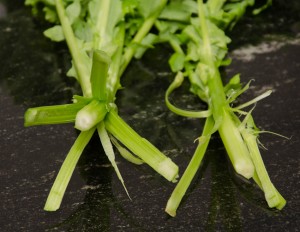It is the season to demonstrate again my recognition and enjoyment for Cime di rape (Cime di rapa is the singular). Also known as Rapini or Broccoli Rabe in some other parts of Italy and of the world. This exceptional, slightly bitter, mustard tasting, green vegetable is a brassica and a winter green and I make the most of it while it is in season.
I cooked a bunch last night of “Cime ” as they are generally called, with anchovies for a pasta dish.

Cime di rape are not easy to buy, for example there are only three stalls that sell it at the Queen Victoria Market and you cannot rely on all three having it, but if it is available, it comes home. Some good green grocers also sell Cime di rape, especially those businesses with Italian heritage or that are in locations where Italians shop.

The flower heads are green at the moment, but they will have yellow petals later in the season as demonstrated in the photo below.

Cime di rape, are traditionally cooked with orecchiette (little ears shaped pasta) originating in Puglia, but these green leafy greens are also grown extensively in the Italian regions of Lazio and Campania and further south; they are not as traditionally popular in northern Italy.
I cook the greens as a pasta dressing or as a side dish to gutsy dishes of meat or fish or pulses. They are not a delicate tasting green and therefore need strong flavours – garlic, chillies, strong tasting cheese.
As a pasta sauce they can include the flavours already mentioned and / or be enriched by the addition of pork sausages, a few slices of a strong tasing salame or ‘Nduja (a soft, spreadable, pork salame originating from Calabria and with a high content of chilies.)

Another strong taste to add are anchovies. I like to add a substantial amount, but I am careful about adding salt to the greens when I sauté them in strong tasting extra virgin olive oil, garlic, and chilli.
The whole bunch can be used and not just the leaves and flowers. Like when cleaning broccoli, the tougher stems/stalks can be stripped of their tough, green layer. There is little wastage.

When I made the orecchiette with Cime di Rape last night I also added grated lemon peel. A friend had just picked some very fresh lemons from her friend’s property. They were so fragrant, I could not resist them.

The anchovies have to be cut finely and tossed about in some extra virgin olive oil to dissolve/ melt. This happens quickly.

The melted anchovies can either be added to the sautéed greens after the pasta and greens have been tossed together and are ready to serve, or at the beginning i. e. sauté the anchovies, add the garlic and chillies in the oil for a couple of minutes before adding the greens and cook.
Use strong tasting grating cheese like pecorino. Last night I used some Aged Goat Gouda cheese instead. Sometimes I top the pasta with feta, this is not traditional, but it is good to experiment.
The lemon peel can be added either during cooking or at the end.
There are other posts with information and recipes on my blog about Cime di rape. I hope that you too will enjoy them :
EDIBLE WEEDS: Orecchiette e Broccoletti Selvatici (and cime di rape)
ONE OF MY FAVOURITE VEGETABLES Cime di Rape







